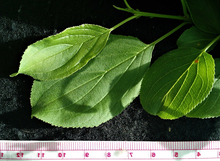Quick facts
Common buckthorn is a Restricted noxious weed. It is illegal to import, sell or transport buckthorn in Minnesota.
- Common buckthorn is found in oak forests, savannas, prairies and riparian woods.
- It completely eliminates plant diversity in the understory over time.
- It thrives on well-drained soils.
- Plants leaf out early and hold their leaves late into the fall, creating dense shade.
- Seeds have a laxative effect on birds, aiding in seed dispersal.
- Common buckthorn is the overwinter host for the soybean aphid.
Common buckthorn should be reported. The Minnesota Department of Natural Resources provides detailed recommendations for reporting invasive species.
How to identify common buckthorn
- Common buckthorn (Rhamnus cathartica) is a tall understory shrub or small tree up to 25 feet high.
- Spreading, loosely branched crown.
- Often multiple stems at base.
- Female and male plants.
Stem
- Shiny gray to brown bark with light-colored lenticels (corky projections).
- Native plums and cherries have similar bark.
Branches
- Cut or stripped branch exposes orange sapwood.
- Twigs often end in stout thorns.
- Terminal buds and thorn often look like a hoof.
Leaves
- Often sub-opposite, sometimes opposite.
- Broadly elliptic, pointed tip, smooth, dark glossy, small-toothed.
- Stays green late into fall.
Flowers
- Inconspicuous, clustered in the axils of leaves.
- Blooms May or June.
Fruit and seeds
- Clusters of black 1/4–1/2 inch fruit ripen on female plants only in August and September.
- Fruits contain 3 to 4 seeds that are viable for 1 to 2 years in the soil.
Roots
- Extensive fibrous root system.
Buckthorn serves as a shelter for soybean aphid eggs to overwinter. It also disrupts the balance of our natural world, pushing out desirable native understory plants and creating a dark, dense thicket.
The following videos show how to identify buckthorn and practices for protecting both crops and the environment.
These Extension videos were produced with support from the Minnesota Soybean Research and Promotion Council.
Reviewed in 2023




